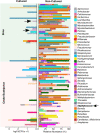Characterization and manipulation of the bacterial community in the midgut of Ixodes ricinus
- PMID: 35810301
- PMCID: PMC9271250
- DOI: 10.1186/s13071-022-05362-z
Characterization and manipulation of the bacterial community in the midgut of Ixodes ricinus
Abstract
Background: Ticks are obligate hematophagous arthropods transmitting a wide range of pathogens to humans and animals. They also harbor a non-pathogenic microbiota, primarily in the ovaries and the midgut. In the previous study on Ixodes ricinus, we used a culture-independent approach and showed a diverse but quantitatively poor midgut bacterial microbiome. Our analysis also revealed the absence of a core microbiome, suggesting an environmental origin of the tick midgut microbiota.
Methods: A bacterial analysis of the midgut of adult females collected by flagging from two localities in the Czech Republic was performed. Using the culture-independent approach, we tested the hypothesis that the midgut microbiome is of the environmental origin. We also cultured indigenous bacteria from the tick midgut and used these to feed ticks artificially in an attempt to manipulate the midgut microbiome.
Results: The midgut showed a very low prevalence and abundance of culturable bacteria, with only 37% of ticks positive for bacteria. The culture-independent approach revealed the presence of Borrelia sp., Spiroplasma sp., Rickettsia sp., Midichloria sp. and various mainly environmental Gram-positive bacterial taxa. The comparison of ticks from two regions revealed that the habitat influenced the midgut bacterial diversity. In addition, the midgut of ticks capillary fed with the indigenous Micrococcus luteus (Gram-positive) and Pantoea sp. (Gram-negative) could not be colonized due to rapid and effective clearance of both bacterial taxa.
Conclusions: The midgut microbiome of I. ricinus is diverse but low in abundance, with the exception of tick-borne pathogens and symbionts. The environment impacts the diversity of the tick midgut microbiome. Ingested extracellular environmental bacteria are rapidly eliminated and are not able to colonize the gut. We hypothesize that bacterial elimination triggered in the midgut of unfed adult females is critical to maintain low microbial levels during blood-feeding.
Keywords: Capillary feeding; Culturing; High-throughput sequencing; Ixodes ricinus; Microbiome; Microbiome manipulation; Midgut.
© 2022. The Author(s).
Conflict of interest statement
The authors declare that the research was conducted in the absence of any commercial or financial relationships that could be construed as a potential conflict of interest.
Figures








Similar articles
-
The immune factors involved in the rapid clearance of bacteria from the midgut of the tick Ixodes ricinus.Front Cell Infect Microbiol. 2024 Aug 13;14:1450353. doi: 10.3389/fcimb.2024.1450353. eCollection 2024. Front Cell Infect Microbiol. 2024. PMID: 39193502 Free PMC article.
-
Poor Unstable Midgut Microbiome of Hard Ticks Contrasts With Abundant and Stable Monospecific Microbiome in Ovaries.Front Cell Infect Microbiol. 2020 May 8;10:211. doi: 10.3389/fcimb.2020.00211. eCollection 2020. Front Cell Infect Microbiol. 2020. PMID: 32457850 Free PMC article.
-
Temporal patterns in Ixodes ricinus microbial communities: an insight into tick-borne microbe interactions.Microbiome. 2021 Jul 3;9(1):153. doi: 10.1186/s40168-021-01051-8. Microbiome. 2021. PMID: 34217365 Free PMC article.
-
What do we know about the microbiome of I. ricinus?Front Cell Infect Microbiol. 2022 Nov 16;12:990889. doi: 10.3389/fcimb.2022.990889. eCollection 2022. Front Cell Infect Microbiol. 2022. PMID: 36467722 Free PMC article. Review.
-
Cysteine proteases from bloodfeeding arthropod ectoparasites.Adv Exp Med Biol. 2011;712:177-91. doi: 10.1007/978-1-4419-8414-2_11. Adv Exp Med Biol. 2011. PMID: 21660665 Free PMC article. Review.
Cited by
-
A metalloprotease secreted by an environmentally acquired gut bacterium hinders Borrelia afzelii colonization in Ixodes ricinus.Front Cell Infect Microbiol. 2024 Oct 10;14:1476266. doi: 10.3389/fcimb.2024.1476266. eCollection 2024. Front Cell Infect Microbiol. 2024. PMID: 39450335 Free PMC article.
-
Rickettsia helvetica in C3H/HeN mice: A model for studying pathogen-host interactions.Heliyon. 2024 Sep 14;10(18):e37931. doi: 10.1016/j.heliyon.2024.e37931. eCollection 2024 Sep 30. Heliyon. 2024. PMID: 39323843 Free PMC article.
-
Analysis of Amblyomma americanum microRNAs in response to Ehrlichia chaffeensis infection and their potential role in vectorial capacity.bioRxiv [Preprint]. 2024 May 6:2024.05.03.592465. doi: 10.1101/2024.05.03.592465. bioRxiv. 2024. Update in: Front Cell Infect Microbiol. 2024 Jul 17;14:1427562. doi: 10.3389/fcimb.2024.1427562. PMID: 38765993 Free PMC article. Updated. Preprint.
-
The Tick Microbiome: The "Other Bacterial Players" in Tick Biocontrol.Microorganisms. 2024 Nov 28;12(12):2451. doi: 10.3390/microorganisms12122451. Microorganisms. 2024. PMID: 39770654 Free PMC article. Review.
-
Bacterial community of ticks (Acari: Ixodidae) and mammals from Arauca, Colombian Orinoquia.Int J Parasitol Parasites Wildl. 2024 May 9;24:100943. doi: 10.1016/j.ijppaw.2024.100943. eCollection 2024 Aug. Int J Parasitol Parasites Wildl. 2024. PMID: 38778917 Free PMC article.
References
-
- Gusmão DS, Santos AV, Marini DC, Bacci M, Berbert-Molina MA, Lemos FJA. Culture-dependent and culture-independent characterization of microorganisms associated with Aedes aegypti (Diptera: Culicidae) (L.) and dynamics of bacterial colonization in the midgut. Acta Trop. 2010;115:275–81. doi: 10.1016/j.actatropica.2010.04.011. - DOI - PubMed
MeSH terms
Grants and funding
- GACR 19-04301S/Czech Science Foundation
- GACR 19-04301S/Czech Science Foundation
- GACR 19-04301S/Czech Science Foundation
- GACR 19-04301S/Czech Science Foundation
- GACR 19-04301S/Czech Science Foundation
- GACR 19-04301S/Czech Science Foundation
- CZ.02.1.01/0.0/0.0/16_019/0000759/European Regional Development Fund (ERDF) and Ministry of Education, Youth and Sport (MEYS).
- CZ.02.1.01/0.0/0.0/16_019/0000759/European Regional Development Fund (ERDF) and Ministry of Education, Youth and Sport (MEYS).
- CAPES 001/CAPES
LinkOut - more resources
Full Text Sources

